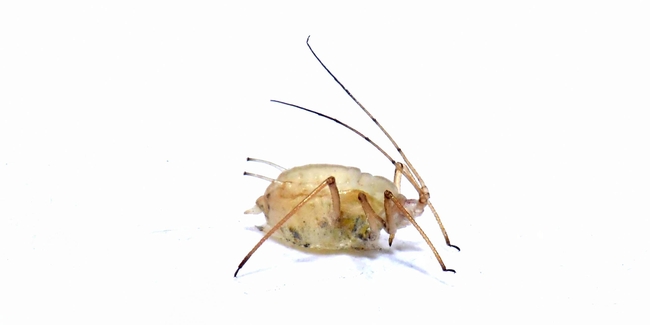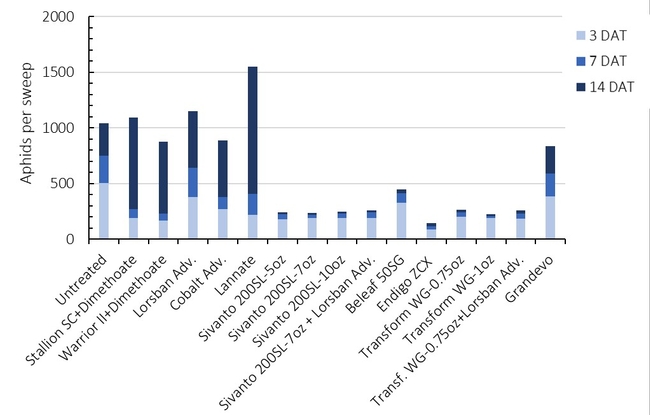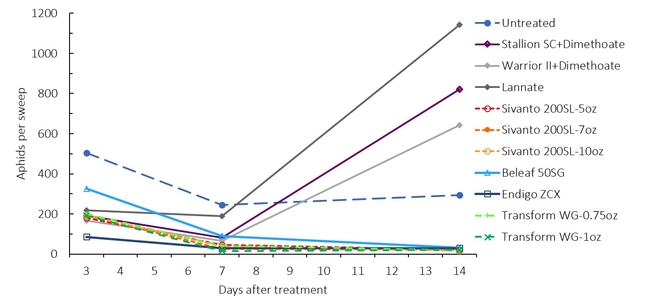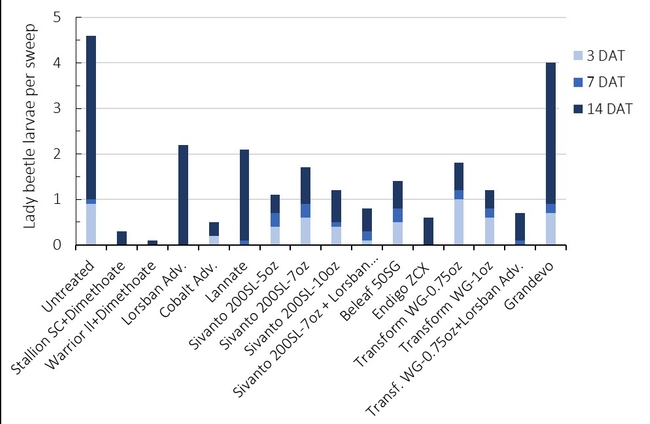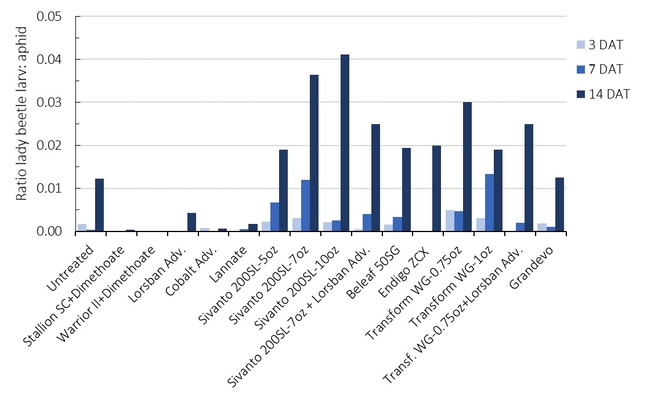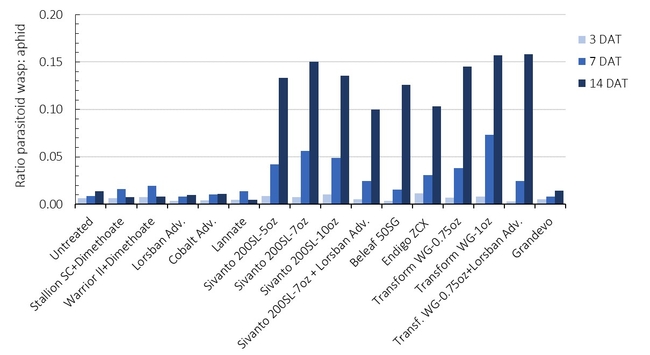"The enemy of my enemy is my friend" holds true in entomology as well!
The activity of natural enemies of pests (beneficial insects) is a key component of Integrated Pest Management in alfalfa to prevent pest resurgence and secondary pest outbreaks.
This is especially true for blue alfalfa aphid (BAA), a challenging pest in alfalfa (see companion article on managing BAA). Although BAA is frequently the most damaging and troublesome aphid to control, spotted alfalfa aphid, pea aphid, and cowpea aphid can also be problematic.
In alfalfa, aphids have many natural enemies. Some, like lady beetles, syrphid flies, and parasitoid wasps target aphids. Others, like damsel bugs and minute pirate bugs, are generalist predators and feed on a variety of prey. Aphids often are very susceptible to predators, with few defenses, and serve as a buffet for natural enemies. So, how are aphids so successful? They reproduce asexually and bear live young, leading to very short generation times and rapid exponential growth.
Accounting for natural enemies can help take advantage of their services and avoid potential pest resurgence and secondary pest outbreaks. Choosing a selective insecticide that targets aphids with minimal effect on natural enemies helps extend control and reduce the need for additional insecticide sprays. After the insecticide loses efficacy, preserved natural enemies are there to suppress any aphids that remain, a bio-residual effect. Killing most of the aphids, but not all, AND killing all of the natural enemies lead to aphid resurgence or secondary pest outbreaks.
The value of beneficials: Experimental evidence
We present data from a trial at the Intermountain Research and Extension from Tulelake, CA conducted by the late Steve Orloff and Rob Wilson in 2015 as an example to illustrate the importance of natural enemies for pest control in alfalfa.
Study overview
- Broad-spectrum materials/mixtures and more selective insecticides were tested.
- Treatments were applied April 17, with one application. Plants were already up and growing, so it is not directly comparable to some of the current scenarios growers are facing with heavily infested plants as they break dormancy.
- Aphids were assessed, 3, 7, and 14 days after treatment, along with natural enemies (lady beetle larvae and braconid parasitoid wasps).
Aphids
Key point: Selective materials provided extended control in this trial, while some of the broad spectrum materials suppressed aphids through 7 days, but then flared them by 14 days.
There were differences in short (7 day) vs extended (14 day) control. The three-day assessment is useful, but also not as relevant for newer materials that take longer to act, which may be especially true under cooler conditions. While some of the treatments gave good control through 7 days, control had disappeared at 14 days, with higher populations than even in the untreated (see Dimethoate + Warrior II and Lannate in Figs. 3 and 42). Sivanto, Transform, and Endigo ZCX all kept aphid populations very low through 14 days (extended control) and Beleaf also performed well in this trial, but has a 62-day PHI that limits its use.
Figure 3. Aphid populations across the three treatment dates for all of the tested treatments, assessed with a sweep net.
Figure 4. Aphid populations across the three treatment dates for a subset of the tested treatments to illustrate flaring of aphid populations at 14 days after treatment vs. extended control with other treatments (same data as Fig. 3).
Natural Enemies
Key point: Some treatments were very harsh on natural enemies, while others preserved their populations. Those that killed aphids AND preserved natural enemies (high ratio of natural enemies to aphids) provided excellent extended control through 14 days and likely afterwards as well.
So, what happened? Natural enemies clearly played a role here in terms of short- vs. long-term control. The broad-spectrum materials generally provided good control through 7 DAT. However, between 7 and 14 DAT, aphid populations surged in some treatments, left largely unchecked by natural enemies. We show both absolute counts (Fig. 5) and natural enemy: aphid ratios (Figs. 6 and 7). A high natural enemy to aphid ratio indicates that natural enemies are helping keep aphids in check. A low ratio of natural enemies to aphids indicates that the insecticide is doing all of the work and natural enemy numbers are low.
In terms of overall abundance of lady beetle larvae, the untreated check had numerous larvae. Meanwhile, mixtures containing Dimethoate and other broad-spectrum materials obliterated them through 7 days (Fig. 5). In the Lorsban and Lannate treatments, they recolonized the plots by 14 days, responding to the high aphid populations. They were never able to do this in the Dimethoate combination treatments. They also recolonized the Endigo treatment. Sivanto, Transform, and Beleaf all maintained lady beetle populations throughout the study.
By examining the natural enemy:aphid ratio, we can see how these treatments affect natural enemies and how this plays out for aphid management. Here, high values are best and typically indicate low aphid populations coupled with conserved natural enemy populations. For lady beetles (Fig. 6), the treatments of Sivanto and Transform alone, as well as Beleaf, have good ratios 3 and 7 DAT and even better values 14 DAT, illustrating how these materials can control aphids and conserve natural enemies. The Endigo treatment illustrates how natural enemies were wiped out initially (likely by the pyrethroid lambda-cyhalothrin), but then recovered while aphid populations were still low, helping provide control. A high ratio at 14 DAT indicates that natural enemies were able to help suppress aphids and provide a bio-residual effect. Ratios were so low in some broad-spectrum treatments because the aphid populations were too high for whatever natural enemies were there to control them.
The pattern was very similar for the wasp:aphid ratios (Fig. 75). A number of the materials clearly had high wasp to aphid ratios at 7 and 14 DAT, indicating wasps able to help supress the aphids. As with lady beetles, high ratios at 14 DAT indicate the potential for extended control and bio-residual past 14 days.
Figure 5. Lady beetle larvae abundance assessed with a sweep net.
Figure 6. Ratio of lady beetle larvae to aphids (measured per sweep). High values are best and typically indicate low aphid populations coupled with conserved lady beetle populations. A value of 0.04 corresponds to 1 larva per 25 aphids.
Figure 7. Ratio of parasitoid braconid wasps to aphids (measured per sweep). High values are best and typically indicate low aphid populations coupled with conserved parasitoid populations. A value of 0.1 corresponds to 1 wasp per 10 aphids.
Yields
Key point: Extended control of aphids produced the best yields and treatments that had flared aphids, resulting in lower yields than the untreated.
Yields and aphid injury reflected high aphid populations. All of the materials with good aphid control through 14 DAT had first-cutting yields between 1.97 and 2.10 tons/A. The untreated and Grandevo treatment (which behaved much like the untreated) had 1.81 and 1.75 tons/A, respectively. Meanwhile, the Stallion + Dimethoate, and Warrior + Dimethoate only yielded 1.19 and 1.50 tons/A. Lorsban and Cobalt only yielded 1.58 tons/A each. In this case study, some of the materials actually aggravated aphid populations and damage, leading to yield loss. A second application (or more) may have prevented yield losses, but was outside the scope of this trial and would obviously come with additional costs and possible consequences later with other secondary pests such as summer worms.
Conclusions
Watch for natural enemies, and treat when thresholds are reached, or when you consistently see aphids in alfalfa crowns and the plant is growing slower than expected. Take natural enemies into account when deciding if/when to treat and when choosing a material. Continue monitoring post-treatment, especially if using broad-spectrum materials such as an organophosphate or pyrethroid (or some combination).
Treatment options in California are currently limited, but we hopefully will see more selective materials enter the market in the future, such as Sefina (afidopyropen) and Transform (sulfoxaflor). There is a strong need for aphid-specific alternatives which are much softer on natural enemies to prevent aphid pest resurgence and secondary pest outbreaks.
This article was first published in the Alfalfa and Forage News Blog.

